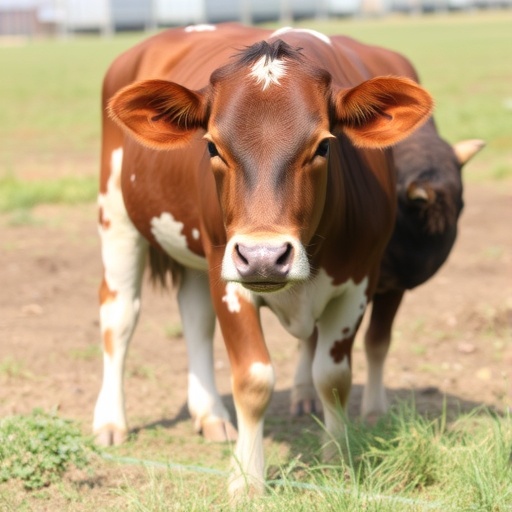In recent years, lumpy skin disease (LSD) has emerged as a significant threat to cattle health, particularly in tropical and sub-tropical regions. This viral disease, caused by the lumpy skin disease virus (LSDV), is a member of the Capripoxvirus genus, which also includes sheep pox and goat pox viruses. Originating in Africa, LSD has spread to various parts of Asia and the Middle East, causing substantial economic losses to the livestock industry. The disease is characterized by the appearance of nodules on the skin, fever, and, in severe cases, can lead to complications that may endanger the lives of affected animals.
As the prevalence of lumpy skin disease continues to rise, researchers are increasingly focused on its epidemiology and the methods available for effective management. In Khulna, Bangladesh, a recent study conducted by Kumar et al. delved deep into the prevalence of LSD among cattle populations, revealing concerning rates of infection. In rural areas, where cattle play an integral role in farmers’ livelihoods, the implications of LSD are profound, affecting not just animal health but also the economic stability of communities reliant on livestock farming.
The study aimed to assess the prevalence of lumpy skin disease in Khulna, where outbreaks have been reported in recent years. A careful examination of cattle populations was undertaken to identify the rates of infection and the impact on the overall health of the affected animals. The findings highlighted that a significant proportion of cattle in the region had been exposed to the virus, raising alarms about the potential for outbreaks to escalate if not managed promptly.
In addition to measuring the prevalence of the disease, the researchers also evaluated the efficacy of various antibacterial drugs on secondary bacterial infections arising from the viral infection. Secondary infections often complicate the treatment of viral diseases, and understanding the effectiveness of these drugs can significantly improve treatment protocols. In a population already weakened by LSD, secondary bacteria can lead to further health complications, emphasizing the need for a comprehensive approach to manage and treat the disease effectively.
Interestingly, the study found that the use of antibacterial drugs did show potential in mitigating the effects of secondary infections associated with LSD. While antibiotics do not directly combat viral infections, they can provide critical support in preventing bacterial complications, a common occurrence in animals suffering from viral diseases. This critical finding offers hope for improving treatment options available to farmers and veterinarians dealing with LSD in Bangladesh.
Lumpy skin disease is primarily transmitted through insect vectors, such as mosquitoes and ticks, which pose additional challenges to controlling its spread. The region’s tropical climate creates favorable conditions for these vectors, exacerbating the situation. The researchers emphasized the importance of vector control in their findings, suggesting that integrated pest management strategies could play a vital role in reducing the incidence of LSD.
Public awareness and education on the signs and symptoms of lumpy skin disease are also crucial for early identification and management. Farmers must be informed about the risks associated with the disease and the importance of reporting cases promptly. By fostering communication between communities, veterinarians, and agricultural agencies, a more effective response to outbreaks can be developed.
In the face of rising antibiotic resistance, it is essential for researchers to continue exploring innovative and sustainable methods for managing both lumpy skin disease and its associated secondary infections. The results of Kumar et al.’s study could pave the way for further research on the development of vaccines or alternative treatments that do not rely on antibiotics, thus promoting the health of cattle herds while adhering to sustainable veterinary practices.
Ultimately, the findings from the study published in Discover Animal demonstrate a critical need for ongoing surveillance of lumpy skin disease in cattle. As the disease continues to pose economic and health challenges to livestock industries, especially in countries like Bangladesh, it becomes increasingly important for policymakers to prioritize animal health initiatives. By investing in research, education, and vector control measures, stakeholders can significantly alleviate the impact of this devastating viral disease.
As the understanding of lumpy skin disease evolves, it is essential to consider a collaborative approach involving veterinarians, researchers, farmers, and policymakers. This holistic strategy will ensure that the significant challenges presented by LSD are met with proactive solutions, safeguarding the health of livestock and the livelihoods of those who depend on them for their daily subsistence.
In conclusion, the alarming prevalence of lumpy skin disease in Khulna, Bangladesh, highlights the urgent need for increased research, surveillance, and management strategies. The contributions made by Kumar et al. shed light on the critical integration of antibacterial treatments in combating secondary infections, ultimately aiming to improve outcomes for affected cattle. As the battle against this disease continues, it is paramount to remain focused on developing innovative and effective methods for treating and controlling LSD, thereby protecting the agricultural future of the region.
Subject of Research:
Lumpy skin disease and antibacterial treatments in cattle.
Article Title:
Prevalence of lumpy skin disease and evaluation of the efficacy of antibacterial drugs against secondary bacterial infection in cattle at Khulna in Bangladesh.
Article References:
Kumar, D.A., Iftakharul, H.M., Iqbal, H.S.M. et al. Prevalence of lumpy skin disease and evaluation of the efficacy of antibacterial drugs against secondary bacterial infection in cattle at Khulna in Bangladesh.
Discov Anim 2, 43 (2025). https://doi.org/10.1007/s44338-025-00086-7
Image Credits:
AI Generated
DOI:
10.1007/s44338-025-00086-7
Keywords:
Lumpy skin disease, cattle, antibacterial drugs, secondary infections, epidemiology, vector control, zoonotic diseases, Bangladesh.




